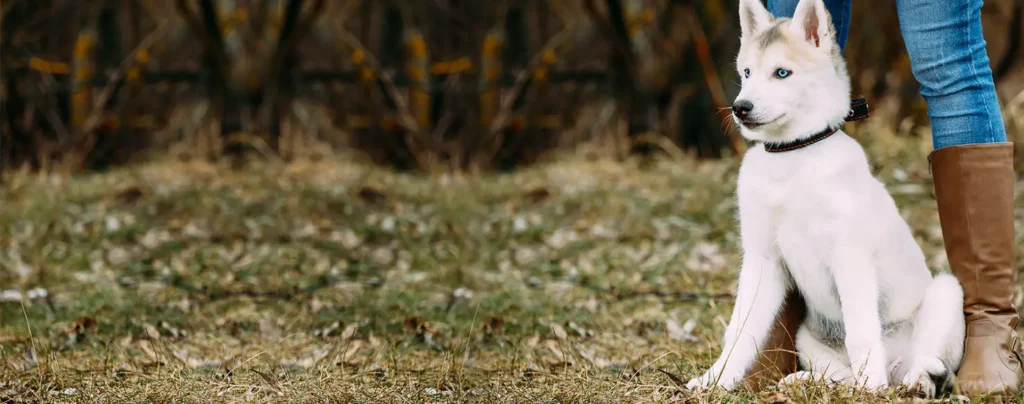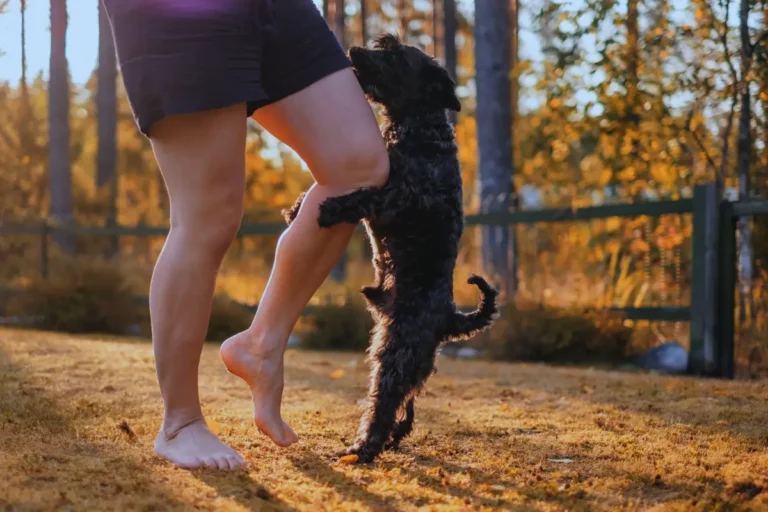Why Does Your Dog Sit on Your Foot? (5 Reasons & How to Respond)
Have you ever been sitting on the couch or standing in the kitchen when suddenly, you feel the pressure of your furry friend plopping down on your foot? It’s a familiar scenario for many dog owners, and it often leaves us wondering what’s going on in our pup’s mind.
Is this simply a sign of affection or is there something more behind this curious behavior?
As dog owners, it’s essential to understand our pets’ behaviors to better communicate and bond with them. This blog post aims to unravel the mystery behind your dog’s foot-sitting behavior, using insights from expert sources such as the American Kennel Club, PetMD, Pure Pet Food, and Sit Means Sit.
We’ll explore the reasons behind this behavior, how to respond to it, and address some frequently asked questions not covered in other articles. So, let’s dive in and get to the bottom of why your dog sits on your foot!
Key takeaways
Dogs sit on your foot for companionship and security.
It demonstrates loyalty and social hierarchy.
Sitting on your foot creates a comforting bond.
Dogs seek warmth and comfort through this behavior.
It can indicate a need for attention and reassurance.
Understand your dog’s body language for insights.
Encourage alternative sitting behaviors for boundaries.
Provide physical and mental stimulation for anxious dogs.
Seek professional help for obsessive behavior.
Appreciate this unique display of love from your dog.
The Connection Between Canine Behavior and Foot-Sitting
The domestication of dogs and pack mentality
Dogs have been domesticated for thousands of years, evolving alongside humans and forming deep bonds with their owners. Their wild ancestors, wolves, lived in packs with complex social structures, and many of their behaviors are still present in our modern-day canine companions.
The pack mentality plays a crucial role in understanding why dogs may choose to sit on your foot.
The human-canine bond
Over time, dogs have come to see their human families as part of their “pack”, forming strong attachments and loyalty to their owners. These bonds lead to various behaviors that may seem odd to us but make perfect sense in the world of canine communication.
Sitting on a human’s foot can be a dog’s way of expressing its connection to its owner, signaling its trust and commitment to its human “pack member.”
Communication cues and body language
Dogs use body language as one of their primary means of communication, both with other dogs and with humans. By observing and understanding their body language, we can gain valuable insights into what our dogs are trying to tell us.
Foot-sitting is a behavior that can carry several meanings, depending on the context and the individual dog’s personality. In the next section, we will explore some of the reasons why your dog might choose to sit on your foot.

Reasons for Foot-Sitting Behavior
1. Establishing dominance
In some cases, a dog may sit on your foot as a way of asserting its dominance over you. While this behavior is more common in multi-dog households, it can also happen between a dog and its human.
If your dog is trying to show its place in the “pack,” it might use your foot as a platform to display its position. However, this is not always a negative behavior and can simply be a part of your dog’s natural instincts.
2. Seeking protection and comfort
For some dogs, sitting on your foot is a sign that they feel safe and protected with you. This behavior can be a way for them to seek comfort, especially in new or stressful situations. By sitting on your foot, your dog is telling you that it trusts you to keep it safe and secure.
3. Marking territory
Dogs are territorial animals, and they often use scent to mark their territory. When a dog sits on your foot, it may be using its body and scent to claim you as part of its territory. This is another way for your dog to show its attachment to you, indicating that it considers you an essential part of its life.
4. Bonding and affection
One of the most common reasons for foot-sitting is simply that your dog wants to be close to you. This behavior is a sign of affection, as your dog enjoys the warmth and comfort of being near its favorite human. Foot-sitting is a sweet and endearing way for your dog to express its love and attachment to you.
5. Anxiety and stress
In some instances, dogs may sit on your foot as a coping mechanism for anxiety or stress. This behavior can be soothing for your dog, providing it with a sense of stability and reassurance.
If your dog exhibits other signs of anxiety, such as excessive panting or whining, it might be worth consulting a veterinarian or a professional dog behaviorist to address the underlying issues.
How to Respond to Your Dog’s Foot-Sitting Behavior
1. When to encourage the behavior
If your dog’s foot-sitting is a sign of affection and bonding, and it doesn’t cause any discomfort or inconvenience, you can choose to encourage the behavior. Enjoying this special connection with your dog can strengthen your relationship and bring joy to both you and your furry friend.
2. When to discourage the behavior
If the foot-sitting behavior is causing problems, such as asserting dominance, triggering allergies, or causing discomfort to you or others in the household, it’s essential to address it appropriately. In some cases, it might be necessary to discourage your dog from sitting on your feet.
3. Training techniques and strategies
To discourage foot-sitting, start by redirecting your dog to an alternative spot to sit or lie down whenever it approaches your feet. You can use positive reinforcement, such as praise or treats, to reward your dog for choosing a different spot.
Be consistent with your training, and over time, your dog should learn to avoid sitting on your feet.
If you’re having difficulty with training or if the foot-sitting behavior is accompanied by other behavioral issues, consider seeking professional help from a certified dog trainer or behaviorist.
4. Building a positive relationship with your dog
Understanding the reasons behind your dog’s foot-sitting behavior and responding appropriately can help build a stronger bond between you and your canine companion. Remember to always approach training and behavior modification with patience, consistency, and a positive attitude, fostering a healthy and loving relationship with your dog.

Exploring Other Foot-Oriented Canine Behaviors
Licking feet
Licking is a common behavior among dogs and can be directed towards their owners’ feet for various reasons. Your dog may lick your feet as a sign of affection or grooming, as a means of seeking attention, or simply because it enjoys the taste of your skin or any residue on your feet.
If the licking becomes excessive or problematic, address it with appropriate training techniques or consult a professional.
Burying items near feet
Dogs have a natural instinct to bury valuable items, such as toys or bones, to keep them safe from other animals. If your dog is burying items near your feet, it might be because it considers you a trusted pack member and feels safe and secure around you.
You can discourage this behavior by offering alternative hiding spots, such as designated toy boxes or digging zones in the yard.
Sniffing and investigating feet
Dogs have an extraordinary sense of smell and may be drawn to your feet because of the various odors they carry. Your feet can tell a story of where you’ve been and what you’ve encountered throughout the day.
Your dog may sniff or investigate your feet out of curiosity, seeking information about your daily activities, or simply enjoying the unique scents.
While this behavior is generally harmless, if it becomes excessive or bothersome, you can use training techniques to redirect your dog’s attention.
Frequently Asked Questions
Why does my dog only sit on my foot when I’m wearing shoes?
Dogs may be attracted to the smell of the shoes or the warmth and comfort they provide. Shoes can carry various odors that your dog finds interesting or comforting. Additionally, some dogs may prefer the firm surface provided by shoes as opposed to bare feet.
If the behavior is problematic, consider redirecting your dog to an alternative spot to sit or lie down when you’re wearing shoes.
Is foot-sitting harmful to my dog?
No, as long as the behavior is not causing distress or leading to negative interactions. Foot-sitting is generally a harmless behavior that can be a sign of affection or bonding between you and your dog.
However, if the foot-sitting is causing issues, such as aggression or dominance-related problems, it’s essential to address the behavior through training or professional assistance.
Why does my dog only sit on certain people’s feet?
Dogs may feel a stronger bond or sense of security with specific individuals. Your dog might choose to sit on the feet of the person it feels most connected to or someone who provides a sense of safety and protection.
This behavior can also be influenced by a person’s scent or body language, which might be more appealing or comforting to the dog.
How can I stop my dog from sitting on my feet if I’m allergic?
Implement consistent training techniques and offer an alternative location for your dog to sit or lie down. Redirect your dog to a designated spot, such as a dog bed or a specific area of the room, whenever it attempts to sit on your feet.
Reward your dog with praise or treats for choosing the alternative spot. Be consistent with your training, and your dog should learn to avoid sitting on your feet over time. If needed, consult a professional dog trainer or behaviorist for assistance.
Final Thoughts
As dog owners, it’s crucial to comprehend and appreciate the reasons behind our furry friends’ behaviors. By learning why your dog sits on your foot, you can better understand its motives, needs, and emotions, allowing you to communicate more effectively and foster a stronger bond with your canine companion.
Recognizing and responding to your dog’s body language and cues can lead to a happier and healthier relationship for both of you.
The world of canine behavior is complex and fascinating, with foot-sitting being just one example of the many ways dogs communicate with their humans. By understanding the reasons behind this behavior and responding appropriately, you can ensure a loving and positive connection with your dog.
Remember, patience, consistency, and a positive attitude are key when it comes to building a strong and lasting bond with your furry family member.






